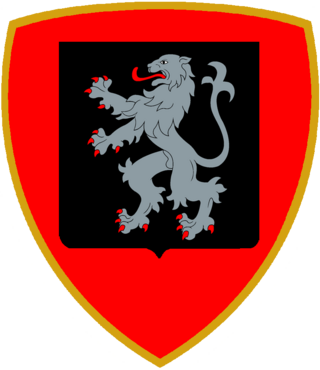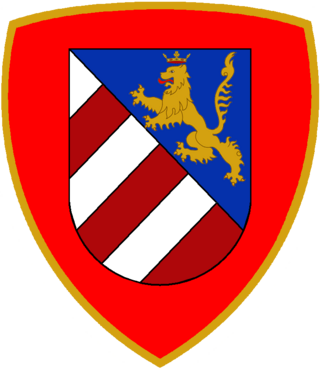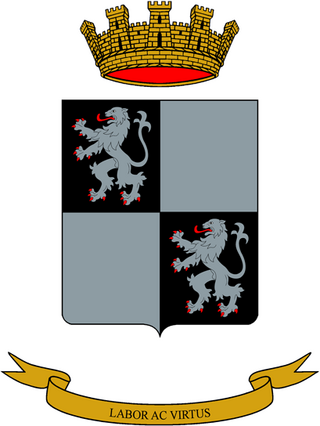
The Mechanized Brigade "Aosta" is a mechanized infantry brigade of the Italian Army based on the island of Sicily. The Brigade is one of the oldest of the Italian Army and the name connects the brigade to its original area of recruitment the Aosta Valley and therefore the brigade's coat of arms is modeled after the coat of arms of Aosta. The brigade is part of the Division "Acqui".

After World War II the Italian Army had two units named "Centauro": from 1952 to 1986 the Armored Division "Centauro" and from 1986 to 2002 the Armored Brigade "Centauro". Both units were successor to the World War II era 131st Armored Division "Centauro". The units' name came from the mythological race of half human-half horse creatures named Centaurs.

The 132nd Armored Brigade "Ariete" is currently the only active armored brigade of the Italian Army. Its core units are tank and Bersaglieri regiments. The brigade's headquarters is in Pordenone, and most of its units are based in the North-East of Italy. The brigade's name comes from the battering ram. The brigade draws much of its historical traditions from the 132nd Armored Division "Ariete," which fought in the Western Desert Campaign of World War II. In 1948, the Ariete was reconstituted as a division and remained active until 1986. Today the brigade is part of the Division "Vittorio Veneto".

The Mechanized Brigade "Gorizia" was a mechanized brigade of the Italian Army. Its core units were mechanized infantry battalions. The brigade's headquarters was in the city of Gorizia and the brigade's units were based in the region of Friuli-Venezia Giulia. The brigade's name was chosen in memory of the World War I Battle of Gorizia. The brigade's sister brigade, the Armored Brigade "Vittorio Veneto", was named to commemorate the World War I Battle of Vittorio Veneto.

The Mechanized Brigade "Mantova" was a mechanized brigade of the Italian Army. Its core units were mechanized infantry battalions. The brigade's headquarters was in the city of Cividale del Friuli and all the brigade's units were based in the region of Friuli-Venezia Giulia. In 2003, the "Mantova" was raised again as a division command.

The Mechanized Brigade "Legnano" was a mechanized brigade of the Italian Army. Its core units were mechanized infantry battalions. The brigade's headquarters was in the city of Bergamo in Lombardy. The name of the brigade commemorates the Lombard League victory in the Battle of Legnano in 1176 and its coat of arms depicts the Monument to the Warrior of Legnano in the centre of Legnano.

The Mechanized Division "Folgore" was a mechanized division of the Italian Army. Its core units were three mechanized brigades. The brigades headquarters was in the city of Treviso.

Operational Land Forces Command is the Italian Army's major command tasked with the operational and administrative control of most of its combat forces. COMFOTER reports directly to the Chief of Staff of the Italian Army. The command is based in Rome.
The Military ranks of the Kingdom of Italy were the military insignia used by the Italian Armed Forces when Italy was the Kingdom of Italy (1861–1946). During the World Wars, the Carabinieri, as the then-most senior corps of the Army, wore similar insignia to those used by the rest of the service.

The Logistic Battalion "Cremona" is an inactive military logistics battalion of the Italian Army, which was assigned to the Motorized Brigade "Cremona". Since 1 November 2019, the flag of the Logistic Battalion "Cremona" is assigned to the Logistic Regiment "Sassari" in Sardinia. The battalion's anniversary falls, as for all units of the Italian Army's Transport and Materiel Corps, on 22 May, the anniversary of the Royal Italian Army's first major use of automobiles to transport reinforcements to the Asiago plateau to counter the Austro-Hungarian Asiago Offensive in May 1916.

The Logistic Regiment "Aosta" is a military logistics regiment of the Italian Army based in Palermo in Sicily. The regiment was formed on 1 June 2015 and is the logistic unit of the Mechanized Brigade "Aosta". On 20 November 2015, the regiment received the flag of the Logistic Battalion "Aosta" and thus received the name and traditions of the Logistic Battalion "Aosta". The regiment's anniversary falls, as for all units of the Italian Army's Transport and Materiel Corps, on 22 May, the anniversary of the Royal Italian Army's first major use of automobiles to transport reinforcements to the Asiago plateau to counter the Austro-Hungarian Asiago Offensive in May 1916.

The Artillery Command is an Italian Army command, which trains the personnel destined for the army's artillery units, develops the army's artillery doctrine, and supervises the Italian army's artillery units.

The 46th Signal Regiment is a national support signals regiment of the Italian Army based in Palermo in Sicily and Nocera Inferiore in Campania. The unit was formed as a battalion in 1976 and named for Mount Mongibello. At the time the battalion operated the army's telecommunications network on the island of Sicily. In 1997, the battalion lost its autonomy and entered the newly formed 46th Signal Regiment. In 1998, the 46th Signal Regiment was assigned to the army's Signal Command. On 1 January 2001, the regiment received the Signal Battalion "Vulture" from the disbanded 45th Signal Regiment, which operated the army's telecommunications network in southern Italy. Since then the regiment operates the army's telecommunications network in southern Italy and Sicily. The regiment's anniversary falls, as for all signal units, on 20 June 1918, the day the Austro-Hungarian Army began its retreat across the Piave river during the Second Battle of the Piave River.

The Transit Areas Management Regiment is a military logistics regiment of the Italian Army based in Bellinzago Novarese and Bari. The regiment is operationally assigned to the Logistic Support Command and manages the reception, staging and onward movement of equipment, personnel, and materiel from Italy to Italian military operations abroad. The regiment provides, together with the 6th General Support Logistic Regiment, third line logistic support for the army's brigades and Rapid Deployable Corps – Italy. The regiment was formed on 1 January 2015 by reorganizing and expanding the 1st Transport Regiment. The regiment's anniversary falls, as for all units of the Italian Army's Transport and Materiel Corps, on 22 May, the anniversary of the Royal Italian Army's first major use of automobiles to transport reinforcements to the Asiago plateau to counter the Austro-Hungarian Asiago Offensive in May 1916.

The 6th General Support Logistic Regiment is a military logistics regiment of the Italian Army based in Budrio in the Emilia Romagna. The regiment is assigned to the Logistic Support Command and manages the transport of equipment, personnel, and materiel from the logistic transit areas to military units in operations. The regiment provides, together with the Transit Areas Management Regiment, third line logistic support for the army's brigades and Rapid Deployable Corps – Italy. The regiment's anniversary falls, as for all units of the Italian Army's Transport and Materiel Corps, on 22 May, the anniversary of the Royal Italian Army's first major use of automobiles to transport reinforcements to the Asiago plateau to counter the Austro-Hungarian Asiago Offensive in May 1916.

The Signal Command is a signals formation of the Italian Army. The Signal Command was established in Rome on 1 January 2017 following the disestablishment of the Army Information and Signals Command and of the Signals Brigade.

The Artillery School was the training establishment of the Arm of Artillery of the Italian Army.

The 87th Infantry Regiment "Friuli" is an active unit of the Italian Army based in Bologna in the Emilia-Romagna. The regiment is named for the region of Friuli and part of the Italian Army's infantry arm. On 1 October 2022 the name, flag and traditions of the regiment were assigned to the Command and Tactical Supports Unit "Friuli" of the Airmobile Brigade "Friuli".

The 157th Infantry Regiment "Liguria" is an inactive unit of the Italian Army last based in Albenga. The regiment is named for the region of Liguria and part of the Italian Army's infantry arm.

The 42nd Signal Battalion "Pordoi" is a signals battalion of the Italian Army. The battalion was formed in 1953 and operated the army's telecommunications network in the Friuli-Venezia Giulia, Trentino-Südtirol, and Veneto regions. In 1975, the battalion was named for the Pordoi Pass and received its own flag. In 1993, the battalion was disbanded and its personnel and tasks transferred to the 32nd Signal Regiment. In 2001, the battalion was reformed and assigned to the 2nd Alpine Signal Regiment as the regiment's second signal battalion. The battalion's anniversary falls, as for all signal units, on 20 June 1918, the day the Austro-Hungarian Army began its retreat across the Piave river during the Second Battle of the Piave River.



















